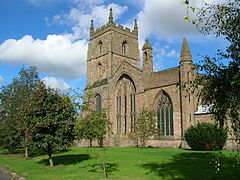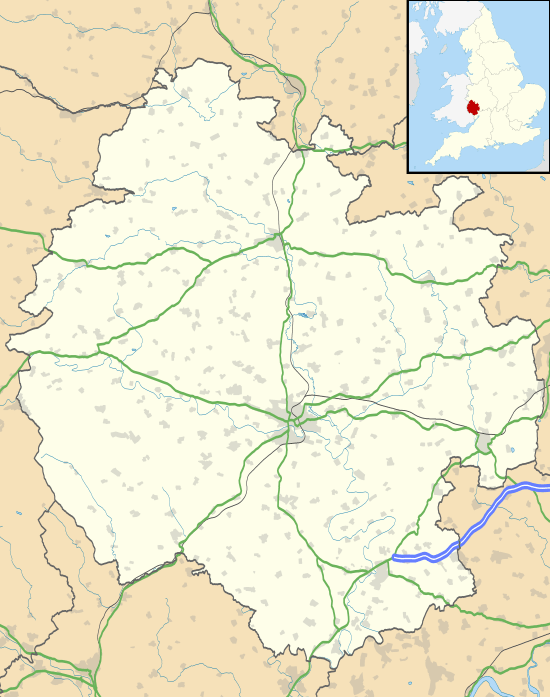Leominster
Leominster (/ˈlɛmstər/ (![]()
| Leominster | |
|---|---|
 Leominster Priory | |
 Leominster Location within Herefordshire | |
| Population | 11,691 [1] |
| OS grid reference | SO496591 |
| Civil parish |
|
| Unitary authority | |
| Ceremonial county | |
| Region | |
| Country | England |
| Sovereign state | United Kingdom |
| Post town | LEOMINSTER |
| Postcode district | HR6 |
| Dialling code | 01568 |
| Police | West Mercia |
| Fire | Hereford and Worcester |
| Ambulance | West Midlands |
| UK Parliament | |
From 1974 to 1996, Leominster was the administrative centre for the former local government district of Leominster.
Toponymy
The town takes its name from the English word minster, meaning a community of clergy and the original Celtic name for the district Leon or Lene, probably in turn from an Old Welsh root lei to flow.[2] The Welsh name for Leominster is Llanllieni. with Llan suggesting a possible Celtic origin to the town's religious community.
Contrary to certain reports, the name has nothing to do with Leofric, an 11th-century Earl of Mercia (most famous for being the miserly husband of Lady Godiva).
History
During the Early Middle Ages, Leominster was home to Æthelmod of Leominster, an English saint known to history mainly through the hagiography of the Secgan Manuscript.[3] He is reputedly buried in Leominster.
During the 8th and 9th Century, Danes (or Vikings) frequently raided the area. In 2015, two individual (operating without landowner permission), using metal detectors, found a large hoard near Leominster (the Leominster hoard) consisting primarily of Saxon jewellery and silver ingots but also coins; the latter date to around 879 CE. According to a news report, "experts believe it was buried by a Viking during a series of raids", while Wessex was ruled by Alfred the Great and Mercia by Ceolwulf II of Mercia. [4]
According to the Anglo-Saxon Chronicle, a raid by Gruffudd ap Llywelyn on Leominster in 1052 resulted in the Battle of Llanllieni, between the Welsh and a combined force of Normans (mercenaries) and English Saxons.[5]
Henry I bestowed the minster and its estates on Reading Abbey, which founded a priory at Leominster in 1121, although there was one here from Saxon times.[6] Its Priory Church of St. Peter and St. Paul, which now serves as the parish church, is the remaining part of this 12th-century Benedictine monastery. Quatrefoil piers were inserted between 1872–79 by Sir George Gilbert Scott.[7]
The priory was ransacked by the Welsh forces of Owain Glyndŵr after their victory at the Battle of Bryn Glas near Pilleth in 1402, along with several local manor houses.
Investigations to the north of the priory in 2005 located the position of the cloister, although most of the stone had been stolen following the Dissolution. Discarded animal bones found on the site when submitted to carbon dating showed that the area was occupied in the 7th century. This agrees with the date of 660 CE associated with the founding myth, which suggests a Christian community was established here by a monk, St. Edfrid, from Northumberland.
Leominster is also the historical home of Ryeland sheep, a breed once famed for its "Lemster" [sic] wool, known as 'Lemster ore'. This wool was prized above all other English wool in trade with the continent of Europe in the Middle Ages. It was the income and prosperity from this wool trade that established the town and the minster and attracted the envy of the Welsh and other regions.
From approximately 1748 to 1754, Pinsley Mill in Leominster was home to one of the Paul-Wyatt cotton mills, the first four cotton mills in the world, employing the spinning machines of Lewis Paul and John Wyatt.[8] The mill was financed by Lancashire native Daniel Bourn, and was partly owned by other men from Lancashire. Bourn introduced his own version of the carding engine to work at this mill, and of the four Paul-Wyatt mills, it may have been the most successful, as shortly after the fire that destroyed the mill, it was reported that the cotton works "had been viewed with great pleasure and admiration by travellers and all who had seen them."[9]
One of the last ordeals by ducking stool took place in Leominster in 1809, with Jenny Pipes as the final incumbent.[10] The ducking stool is on public display in Leominster Priory; a mechanised depiction of it is featured on the town clock.[11]
Climate
As with all towns in the United Kingdom, Leominster has a maritime climate, with mild winters and summers. The data below is from a weather station in Preston Wynne, a village about 10 miles South East of Leominster.
| Climate data for Preston Wynne, elevation 84 metres (276 ft), 1971–2000 | |||||||||||||
|---|---|---|---|---|---|---|---|---|---|---|---|---|---|
| Month | Jan | Feb | Mar | Apr | May | Jun | Jul | Aug | Sep | Oct | Nov | Dec | Year |
| Average high °C (°F) | 6.9 (44.4) |
7.3 (45.1) |
9.9 (49.8) |
12.3 (54.1) |
15.9 (60.6) |
18.7 (65.7) |
21.5 (70.7) |
21.2 (70.2) |
18.0 (64.4) |
13.9 (57.0) |
10.0 (50.0) |
7.8 (46.0) |
13.6 (56.5) |
| Average low °C (°F) | 1.1 (34.0) |
0.9 (33.6) |
2.4 (36.3) |
3.3 (37.9) |
6.0 (42.8) |
8.7 (47.7) |
10.8 (51.4) |
10.6 (51.1) |
8.6 (47.5) |
6.0 (42.8) |
3.0 (37.4) |
1.7 (35.1) |
5.3 (41.5) |
| Source: YR.NO[12] | |||||||||||||
Transport
The 4-mile (6.4 km) A49 £9 million bypass opened in November 1988. The town also has a bus station linking it to Hereford and a number of nearby towns and villages.
Railways
Leominster railway station has Transport for Wales services on the Welsh Marches Line, northbound to Manchester Piccadilly via Ludlow, Shrewsbury and Crewe as well as Holyhead via Shrewsbury, Wrexham General and Chester and southbound to Milford Haven or Cardiff Central via Hereford and Abergavenny and Newport; links to London Paddington are achieved by changing at Hereford, for services via Worcester and Oxford, or at Newport, South Wales.
Schools
Earl Mortimer college, is a state comprehensive school providing secondary education for about 650 pupils. The town has two primary schools; Leominster Primary School and Westfield's School. Primary schools in the villages around the town include Ivington, Kimbolton, Kingsland, Luston and Stoke Prior
Media
In print, Leominster is served by the Hereford Times, The Leominster News and the Teme Valley Times. Local radio stations are Sunshine Radio, Sunshine 855, BBC Hereford & Worcester and Free Herefordshire & Worcestershire.
Notable people

- Saint Cuthfleda was the abbess of the nunnery at Leominster and the patroness of the region.[13] Known for her holiness and chaste life.
- Æthelmod of Leominster Anglo-Saxon Saint
- Leofric, Earl of Mercia and his wife Godgifu Lady Godiva – are commemorated as benefactors of the monastery at Leominster[14]
- John Abel (1578/9-1675), an English carpenter and mason, granted the title of 'King's Carpenter', who was responsible for several notable structures in the ornamented half-timbered construction, notably the market house known as Grange Court (1633) in Leominster, which originally stood in Broad Street, but was rebuilt in 1855 near to the Priory Church. It is widely regarded as one of Abel's finest works.[15]
- John Scarlett Davis (1804–1845), artist, was born at 2 High Street. A number of his works are in Leominster Museum.[16]
- Arthur Peppercorn (1889–1951), locomotive designer[17]
- Jarrod Bowen (1996-), footballer for West Ham United[18]
Local attractions
- Croft Castle
- Berrington Hall
- Grange Court, Leominster town centre
- Leominster Museum
- Broadfield Court
- Burford House Gardens
- Priory Church, Leominster
- Monkland Cheese dairy
- Hampton Court
- Stockton Bury Gardens
References
- "Neighbourhood Statistics – Area: Leominster (Parish) – Sex, 2011 (QS104EW)". United Kingdom Census 2011. Office for National Statistics. 2011. Archived from the original on 12 January 2014. Retrieved 12 January 2014.
- J. & C. Hillaby, Leominster Minster, Priory, and Borough c.660–1539 (Logaston Press, Almeley, Herefs. 2006), 4–5.
- Stowe MS 944 Archived 3 January 2014 at Archive.today, British Library
- "MILLIONS OF DOLLARS OF VIKING TREASURE THAT COULD REWRITE HISTORY STOLEN, METAL DETECTORISTS CONVICTED". Newsweek. 22 November 2019. Retrieved 24 November 2019.
An example of a rare two emperor coin, hinting at a previously-unknown alliance between the kingdoms of Wessex and Mercia.
- Evans, Gwynfor (1974). Land of My Fathers: 2000 Years of Welsh History. Y Lolfa. p. 156. ISBN 9780862432652.
- Hillaby, 53-7
- The Buildings of England: Herefordshire, Nikolaus Pevsner, (1963) p226 ISBN 0-14-071025-6
- Wadsworth, Alfred P.; Mann, Julia De Lacy (1931). The Cotton Trade and Industrial Lancashire, 1600–1780. Manchester: Manchester University Press. pp. 433–448.
- Manchester Mercury, reported on 5 November 1754
- Rejali, Darius (2009). Torture and democracy (1. paperback printing. ed.). Princeton, N.J.: Princeton University Press. p. 282. ISBN 0691143331.
- "Herefordshire clock on go slow". Hereford Times. 5 August 2009. Retrieved 7 May 2013.
- "Climate Normals 1971–2000". YR.NO. Retrieved 2 March 2011.
- Cuthfleda, Oxford Dictionary of Saints, 5th ed, 2011. Accessed 5 January 2014.
- The Chronicle of John of Worcester ed. and trans. R.R. Darlington, P. McGurk and J. Bray (Clarendon Press: Oxford 1995), pp.582–3.
- "John Abel, King's carpenter", Grange Court website. Accessed 5 January 2014.
- Hobbs, Tony (2004). John Scarlett Davis: A Biography. Almeley, Herefordshire: Logaston Press. ISBN 1904396151.
- "Arthur Peppercorn", A1 Steam Locomotive Trust. Accessed 5 January 2014.
- Fisher, Ben (16 January 2019). "Jarrod Bowen: from playing without pay to scoring for fun at Hull" – via www.theguardian.com.
External links
- Leominster Town Council
- Leominster History from Archenfield Archaeology (this site is not available)
- Leominster at Curlie